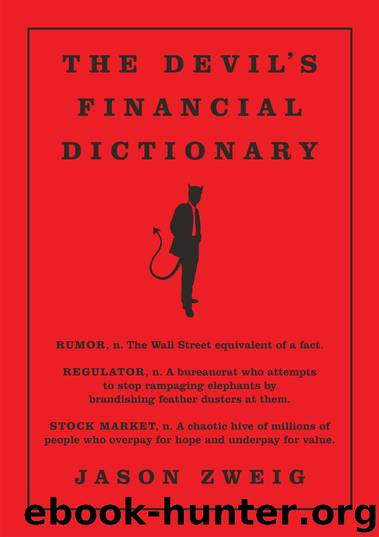The Devil's Financial Dictionary by Jason Zweig

Author:Jason Zweig
Language: eng
Format: epub, mobi
ISBN: 9781610396066
Publisher: PublicAffairs
Published: 2015-09-07T16:00:00+00:00
“Two Fools Dancing,” Hendrick Hondius after Pieter Bruegel the Elder, engraving, 1642. RIJKSMUSEUM
Herding is common among individual investors; security analysts, government-bond traders, professional futures traders, mutual-fund managers, hedge-fund managers, and the biggest buyers of exchange-traded funds; within industrial sectors of the stock market; and across stock markets around the world. Investors herded into technology stocks in 1999 and out of them in 2000; into real estate and financial stocks in 2007 and out in 2008; into gold in 2011 and out by 2014. Before that, they herded into the NIFTY FIFTY stocks in 1972 and out in 1973–1974; into computer and education stocks in 1968 and out in 1969; into uranium and bowling and aeronautics stocks in the 1950s and then right out; into utility stocks and investment trusts in 1928 and out in 1929; and so forth and so on, with numbing repetition, back into the mists of markets immemorial.
Somehow it seems altogether fitting that the first known market forecasters, the BARUs of ancient Mesopotamia, tried predicting what was to come by examining the livers of sheep.
See also CONTRARIAN; ROTATION.
HEURISTICS, n. Mental shortcuts, such as ANCHORING, AVAILABILITY, and REPRESENTATIVENESS, that substitute intuition for analysis based on probabilities and statistical evidence; from the Greek eureka, “I have found it.” In the short run, people who invest on the basis of heuristics have all the fun; in the long run, those who invest on the basis of statistics amass all the wealth.
HFT, abbr. n. See HIGH-FREQUENCY TRADING.
HIGH-FREQUENCY TRADING, n. A technique often used to cheat other traders by a few fractions of a penny in a few millionths of a second, much faster than deceptive trading used to be. The practice of snooping on stock quotes and using private information to trade ahead of others is as old as Wall Street itself. High-frequency trading became controversial only after it was based on advanced computer technology rather than cheating by hand.
In 1790, high-frequency traders cashed in on Alexander Hamilton’s proposal to restructure the federal debt by hiring fast ships to outrace the spread of the news on land. That enabled the traders to snap up US bonds at bargain prices from holders who were still in the dark.
Around 1835, reporter Daniel H. Craig began boarding steamships in Halifax, Nova Scotia. He swiftly digested the financial news in the European newspapers on board, then recorded it in tiny bulletins on tissue paper that he strapped to the feet of trained carrier pigeons. As each ship approached Boston, Craig released the birds, which homed in on his office, where clerks transcribed the news and distributed it to high-frequency traders who paid up to $500 for each hour they were able to get it ahead of the general public.
One of the earliest known books on the US stock market, Frederick Jackson’s A Week in Wall Street by One Who Knows, published in 1841, describes a high-frequency trader nicknamed “Mr. Eavesdropper,” who put his ear to the keyhole of the door of the stock exchange, “and
Download
The Devil's Financial Dictionary by Jason Zweig.mobi
This site does not store any files on its server. We only index and link to content provided by other sites. Please contact the content providers to delete copyright contents if any and email us, we'll remove relevant links or contents immediately.
Spell It Out by David Crystal(36041)
Professional Troublemaker by Luvvie Ajayi Jones(29588)
We're Going to Need More Wine by Gabrielle Union(18967)
The Secret History by Donna Tartt(18846)
Cat's cradle by Kurt Vonnegut(15184)
The Goal (Off-Campus #4) by Elle Kennedy(13543)
The Social Justice Warrior Handbook by Lisa De Pasquale(12141)
The Break by Marian Keyes(9307)
Crazy Rich Asians by Kevin Kwan(9167)
The remains of the day by Kazuo Ishiguro(8820)
Thirteen Reasons Why by Jay Asher(8794)
Educated by Tara Westover(7941)
The handmaid's tale by Margaret Atwood(7679)
Giovanni's Room by James Baldwin(7191)
Win Bigly by Scott Adams(7094)
This Is How You Lose Her by Junot Diaz(6794)
The Rosie Project by Graeme Simsion(6189)
Six Wakes by Mur Lafferty(6151)
The Power of Now: A Guide to Spiritual Enlightenment by Eckhart Tolle(5605)
